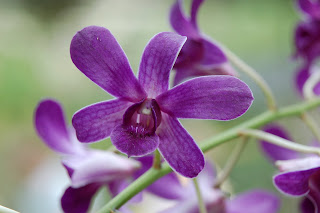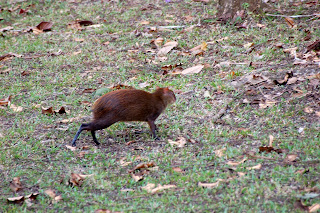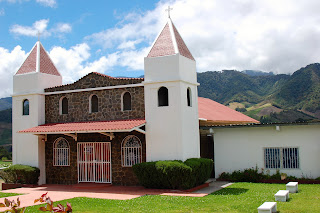We flew AA on frequent flyer miles. All AA flights to Central and South America go through
Panama has two seasons, hot and dry (winter) and hot and humid (summer). The long summer school break is from about Christmas through March.
The eastern region bordering
Central part is the Canal area from
We had two vacations, the first, luxury resorts; second, roughing it with regional buses and planning each day as we went.
Taxi from
Melia 
The hotel staff warned that serious crime was high in
We also talked to a couple who had a rental car and drove around
The canal was interesting; the free trade zone was a disappointment. It is almost entirely commercial sales, large lots of merchandise; no restaurants or even food carts; no place to sit anywhere. We took a taxi out to a restaurant and a taxi back to catch the free bus back to resort.


Brilliance of the Seas, largest ship that can go through
the canal.
The canal is being widened to enable larger ships to pass through. Clearance was 18 inches on each side.
Another tour we took was into the rainforest to visit a village of indigenous Embera Puru Indians. They weave baskets and masks to support themselves, also farming. An interesting thing is that they put a paste of berries and leaves on newborn babies when they are about a week old to keep them from getting sunburned. The Indians are usually naked but dress for the tours. Our native meal was fried fish served in some kind of leaves.


This is a tour that all cruise ships offer. After the tour from the cruise ships, the passengers have lunch at the Melia Panama Canal Resort. This is one reason the resort is so lively.

Several of us hired a guide and van to take us to the historic Spanish garrison port of Portobello about 25 miles northeast of
There are “devils” running around kissing, scaring, etc. Lots of dancing. Unfortunately it was raining and nothing going on.

Carnival time is popular with vacationers and Panamanians alike. We saw no evidence of it except the dancing at the Melia Resort.
After our week at Melia we took a taxi to the Gamboa Rainforest Resort on the


We anticipated macaws and other exotic birds and animals. We didn’t see much and if this is what you’re looking for we do not recommend




We took several tours here to see wildlife.
After dark we went with a guide in a rowboat looking for water animals. The guide had a large flashlight and would shine it every few minutes looking for two red eyes (caymen).
Click on this
picture to see the
cayman's eyes.
We saw capaberra, a rabbit-like animal and three-toed sloths on the grounds.
We also took a tour to

Dredging of the Canal. Pictures taken from the the canopy ride among the treetops at Gamboa Resort.


Ship traveling from Pacific Ocean to Atlantic Ocean.
After all the luxury we were itching to start moving. We flew from
We had no hotel room, didn’t know a thing about the area. Very small A/P, taxi ($1) to town. Actually A/P was in town. Taxi ride was 2 blocks. Driver put our bags in street, we turned around and bags were gone! We thought our luggage was stolen.
Then a boy came after us and directed us to water taxi where our bags were waiting for us.


Water taxi was getting ready to leave so we hopped in with our bags. No choice. Took water taxi, had no idea where we were going. In taxi only few minutes ($1).


There are several areas for scuba diving in
We spent several days here living in our swim suits, walking on the beach, very laid back and rustic. Taking water boats into Bocas, walking around small town in swim suits. We really enjoyed this area.
We talked to several expats living here. They said you can definitely live on only Social Security. From what we saw, it would be very primitive living, but they all said they were happy.
We checked flights to David (Da-VI-da) on the Pacific side. Two flights a week, so we chose a regional bus, thus beginning another adventure. First a water taxi to Bocas (a couple of minutes), then another water taxi (about 15 minutes) to another town.
Scenes along the river in the second
water taxi.

Off the boat into a land taxi (actually a very dirty, old pickup truck). We had no choice; our bags were already thrown into the back of truck. We just followed along like lemmings.
Quick ride on rutted, dirt road to a bus stop, which looked like an old, unused building. Someone threw our bags into back of bus, motioned for us to get on, and away we went. Over the mountains with the locals. What an adventure. Total cost including water taxis was about $10/pp. Four hours of fun.
In David (largest town in area) we found a hotel room for 23/night, also rented auto.
No problems.
David is like small towns everywhere. No Wal-Mart or other big box stores here. The largest stores were smaller than convenience stores in US. Some streets not paved. Major traffic.
A lot of shopping is done on street corners.
For several days we toured the region. It is lush with rich soil from the volcano, many coffee plantations. Lots of hills and cooler than the Canal area. We visited the small villages of Volcan and Boquete. Boquete is where most expats live and where the movement started. All shopping is in David, unless you either fly to Panama City (1 hour) or take the regional bus (8 hours).
Expats can certainly live cheaper but we were told it was quite dangerous to live outside a gated, guarded community. We visited one in Boquete. It was beautifully landscaped, beautiful buildings, rec rooms, etc. Cost was $250,000 cash for Phase I which was almost
sold out. $50K at signing, another $50K when
land was cleared, $50K was footings were poured,etc. Most were being bought as investments by large corporations for their employee “perks”. Only a handful of people actually lived there, giving it a ghost-like appearance.

The landscaping is lush and beautiful.
In this region a tasty meal costs $3-4/pp.
All our meals were basic foods; we never had a bad meal.


This is a beautiful area; lush jungle trees, bright flowers, coffee bean fields. The rich, lava ash soil creates a gorgeous landscape.

It was coffee bean harvesting time.
Beans are picked by hand, mostly be
women wearing peasant-style dresses.
We enjoyed the bus trip so much that we decided to take the bus from David to

A woman met the bus in Panama City offering rooms for $40. Several people went with her, including us. Nice, very basic room. After two days here, we headed home.
Scenes in Panama City.
Click on picture to enlarge. Ships lining up waiting until the Canal opens for Pacific to Atlantic direction.
A beautiful sight on the blue Pacific.
Little English was spoken anywhere except at Melia Resort in
Except for the Canal area, most of Panama is very poor. We decided this kind of life is not for us. The expats who live here are giving up a lot. It is definitely not like home.












































